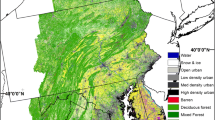Abstract
Assessing and monitoring landscape pattern structure from multi-scale land-cover maps can utilize morphological spatial pattern analysis (MSPA), only if various influences of scale are known and taken into account. This paper lays part of the foundation for applying MSPA analysis in landscape monitoring by quantifying scale effects on six classes of spatial patterns called: core, edge, perforation, branch, connector and islet. Four forest maps were selected with different forest composition and configuration. The sensitivity of MSPA to scale was studied by comparing frequencies of pattern classes in total forest area for various combinations of pixel size (P) and size parameter (S). It was found that the quantification of forest pattern with MSPA is sensitive to scale. Differences in initial composition and configuration influence the amount but not the general tendencies of the variations of morphological spatial pattern (MSP) class proportions with scale. Increase of P led to data generalization resulting in either a removal of the small size features or their potential transformation into other non-core MSP classes, while an increase of S decreases the MSP core area and this process may transform small core areas into the MSP class islet. We established that the behavior of the MSPA classes with changing scale can be categorized as consistent and robust scaling relations in the forms of linear, power, or logarithmic functions over a range of scales.






Similar content being viewed by others
References
Dungan JL, Perry JN, Dale MRT, Legendre P, Citron-Pousty S, Fortin MJ et al (2002) A balanced view of scale in spatial statistical analysis. Ecography 25(5):626–640. doi:10.1034/j.1600-0587.2002.250510.x
GUIDOS Online (2008) On line at: http://forest.jrc.ec.europa.eu/biodiversity/Online_Processing. Accessed August 2008
Hargis CD, Bissonette JA, John L, David JL (1998) The behavior of landscape metrics commonly used in the study of habitat fragmentation. Landsc Ecol 13(3):167–186. doi:10.1023/A:1007965018633
Jelinski DE, Wu J (1996) The modifiable areal unit problem and implications for landscape ecology. Landsc Ecol 11(3):129–140. doi:10.1007/BF02447512
Kozak J, Estreguil C, Ostapowicz K (2008) European forest cover mapping with high resolution satellite data: the carpathians case study. Int J Appl Earth Obs Geoinf 10(1):44–55. doi:10.1016/j.jag.2007.04.003
Levin SA (1992) The problem of pattern and scale in ecology: the Robert H. MacArthur award lecture. Ecology 73(6):1943–1967. doi:10.2307/1941447
Lindenmayer DB, Luck G (2005) Synthesis: thresholds in conservation and management. Biol Conserv 124:351–354
Matheron G (1967) Eléments pour une théorie des milieux poreux. Masson, Paris
Ostapowicz K, Estreguil C, Kozak J, Vogt P (2006) Assessing forest fragmentation and connectivity: a case study in the Carpathians. In: Ehlers M, Michel U (eds) The remote sensing for environmental monitoring, GIS applications, and geology VI, proceedings of SPIE, 6366, 636608, 3 October, 2006
Riitters K, Wickham J, O’Neill R, Jones B, Smith E (2000) Global-scale patterns of forest fragmentation. Conserv Ecol 4(2):3
Riitters KH, Wickham JD, O’Neill RV, Jones KB, Smith ER, Coulston JW et al (2002) Fragmentation of continental United States forests. Ecosystems (N Y, Print) 5:815–822. doi:10.1007/s10021-002-0209-2
Riitters KH, Vogt P, Soille P, Kozak J, Estreguil C (2007) Neutral model analysis of landscape patterns from mathematical morphology. Landsc Ecol 22(7):1033–1044. doi:10.1007/s10980-007-9089-3
Saura S (2004) Effects of remote sensor spatial resolution and data aggregation on selected fragmentation indices. Landsc Ecol 19(2):197–209. doi:10.1023/B:LAND.0000021724.60785.65
Soille P (2003) Morphological image analysis: principles and applications. Springer-Verlag, Berlin
Soille P, Vogt P Morphological segmentation of binary patterns. Pattern Recognit Lett (submitted)
Turner MG, Dale VH, Gardner RH (1989) Predicting across scales: theory development and testing. Landsc Ecol 3(3–4):245–255. doi:10.1007/BF00131542
Urban D, Keitt T (2001) Landscape connectivity: a graph-theoretic perspective. Ecology 82:1205–1218
Vogt P, Riitters KH, Estreguil C, Kozak J, Wade TG, Wickham JD (2007a) Mapping spatial patterns with morphological image processing. Landsc Ecol 22:171–177. doi:10.1007/s10980-006-9013-2
Vogt P, Riitters KH, Iwanowski M, Estreguil C, Kozak J, Soille P (2007b) Mapping landscape corridors. Ecol Indic 7:481–488. doi:10.1016/j.ecolind.2006.11.001
Vogt P, Ferrari JR, Lookingbill TR, Gardner RH, Riitters KH, Ostapowicz K (2009) Mapping functional connectivity. Ecol Indic 9:64–71. doi:10.1016/j.ecolind.2008.01.011
Vos CC, Baveco H, Grashof-Bokdam CJ (2002) Corridors and species dispersal. In: Gutzwiller KJ (ed) Applying landscape ecology in biological conservation. Springer-Verlag, New York, pp 84–104
Wickham JD, Riitters KH, Wade TG, Coulston JW (2007) Temporal change in forest fragmentation at multiple scales. Landsc Ecol 22:481–489. doi:10.1007/s10980-006-9054-6
Wu J (2004) Effects of changing scale on landscape pattern analysis: scaling relations. Landsc Ecol 19:125–138. doi:10.1023/B:LAND.0000021711.40074.ae
Wu J, Shen W, Sun W, Tueller PT (2003) Empirical patterns of effects of changing scale on landscape metrics. Landsc Ecol 17:761–782. doi:10.1023/A:1022995922992
Acknowledgements
We would like to thank two anonymous reviewers for their important comments and suggestions. The research described in this article was performed as a part of the Collaboration Agreement (No. 22832-2005-06 S0SC ISP) between the European Commission, Joint Research Centre, Institute for Environment and Sustainability and the United States Department of Agriculture, Forest Service.
Author information
Authors and Affiliations
Corresponding author
Rights and permissions
About this article
Cite this article
Ostapowicz, K., Vogt, P., Riitters, K.H. et al. Impact of scale on morphological spatial pattern of forest. Landscape Ecol 23, 1107–1117 (2008). https://doi.org/10.1007/s10980-008-9271-2
Received:
Accepted:
Published:
Issue Date:
DOI: https://doi.org/10.1007/s10980-008-9271-2




